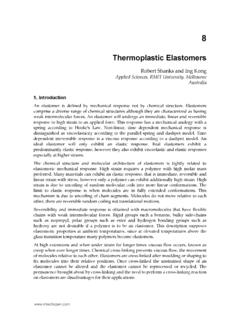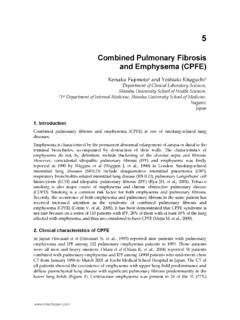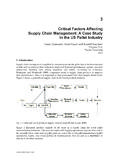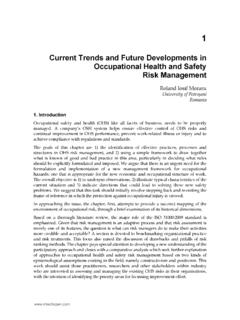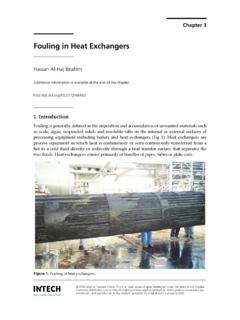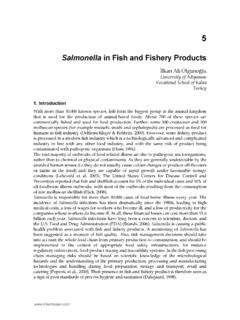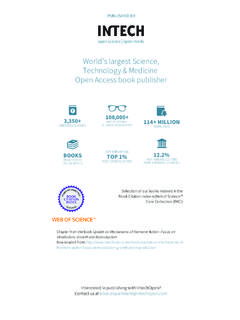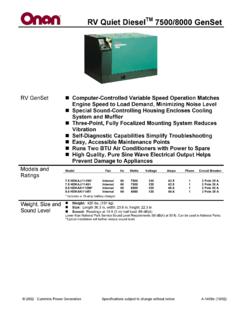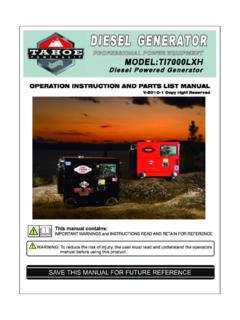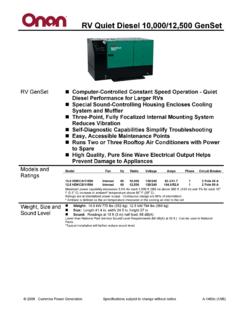Transcription of Micro Gas Turbine Engine: A Review - InTech
1 Chapter 5 Micro Gas Turbine engine : A ReviewMarco Ant nio Rosa do Nascimento,Lucilene de Oliveira Rodrigues,Eraldo Cruz dos Santos, Eli Eber Batista Gomes,Fagner Luis Goulart Dias,Elkin Iv n Guti rrez Vel sques andRub n Alexis Miranda CarrilloAdditional information is available at the end of the IntroductionMicroturbines are energy generators whose capacity ranges from 15 to 300 kW. Theirbasic principle comes from open cycle gas turbines, although they present several typi cal features, such as: variable speed, high speed operation, compact size, simple opera bility, easy installation, low maintenance, air bearings, low NOX emissions and usuallya recuperator (Hamilton, 2001).Microturbines came into the automotive market between 1950 and 1970.
2 The first microtur bines were based on gas Turbine designed to be used in generators of missile launching sta tions, aircraft and bus engines, among other commercial means of transport. The use of thisequipment in the energy market increased between 1980 and 1990, when the demand fordistributed generating technologies increased as well (LISS, 1999).Distributed generation systems may prove more attractive in a competitive market to thoseseeking to increase reliability and gain independence by self-generating. Manufacturers ofgas and liquid-fueled microturbines and advanced Turbine systems have bench test resultsshowing that they will either meet or beat current emission goals for nitrogen oxides (NOX)and other pollutants (Hamilton, 2001).
3 Air quality regulation agencies need to account forthis technological innovation. Emission control technologies and regulations for distributedgeneration system are not yet precisely defined. However, control technologies that could 2014 do Nascimento et al.; licensee InTech . This is an open access article distributed under the terms of theCreative Commons Attribution License ( ), which permitsunrestricted use, distribution, and reproduction in any medium, provided the original work is properly emissions from fossil-fueled components of a distributed generation system to levelssimilar to other traditional fossil-fueled generation equipment are already processes can result in the formation of significant amounts of nitrogen dioxide(NO2) and carbon monoxide (CO).
4 Some manufacturers of microturbines have developedadvanced combustion technologies to minimize the formation of these pollutants. They haveassured low emissions levels from microturbines fueled with gaseous and liquid HistoryIn fact, the technology of microturbines is not new, as researches on this subject can befound since 1970, when the automotive industry viewed the possibility of using microtur bines to replace traditional reciprocating piston engines. However, for a variety of reasons,microturbines did not achieve great success in the automotive segment. The first generationof microturbines was based on turbines originally designed for commercial applications ingenerating electricity for airplanes, buses, and other means of commercial interest in the market for stationary power spread in the mid-1980 and accelerated inthe 1990s, with its reuse in the automobile market in hybrid vehicles and when demand fordistributed generation increased (Liss, 1999).
5 Currently, the operation of hybrid vehiclesthrough a microturbine connected to an electric motor, have received special attention fromsome of the major car manufacturers such as Ford, and research centers (Barker, 1997).In 1978, Allison began a project aimed at the development and construction of generatinggroups for military applications, driven by small gas turbines. The main results obtainedduring testing of these generators revealed: reduction in fuel consumption of 180 l/h to 60l/h, compared with previous models, frequency stability of about 1%, noise levels below 90dB and the possibility of using different fuels (diesel, gasoline, etc.). In 1981, a batch with200 generators was delivered to the Army, and since then, more than 2,000 units havebeen provided to integrate the system of electricity generation for Patriot missile launchers(Patriot Systems) (Scott, 2000).
6 The deregulation of the electricity market in the United States began in 1978 when the Pow er Utility Regulatory Policy Act (PURPA) revolutionized the energy market in the UnitedStates, breaking the monopoly of the electricity generation sector, enabling the beginning ofthe expansion of distributed generation. Since then there has been a significant increase inthe proportion of independent generation in the country and, according to a projectionmade in 1999 by the Gas Research Institute (GRI), this in-house production should reach35% in 2015 (Gri, 1999).With a new market structure, , with the possibility of attracting small consumers ofenergy, microturbines began to be the target of intense research. Already in 1980, underthe support of the Gas Research Institute, a program entitled Advanced Energy System(AES) was initiated with a view to develop a small gas Turbine , with typical features ofaviation Turbine , rated at 50 kW and equipped with a heat recovery for a system cogen Progress in Gas Turbine Performance108eration.
7 The program was abandoned around 1990 by the Gas Research Institute, on thegrounds of problems with the final cost of the product (Watts, 1999). Since then, the GasResearch Institute began to support new projects in partnership with several companies,such as the Northern Research & Engineering Energy Systems, also supporting the firstefforts of Capstone Turbine Corporation (still under the name of its precursor, NoMacEnergy Systems) (Gri, 1999).Some companies in the United States, England and Sweden have recently introduced inthe world market commercial units of microturbines. Among these companies are: Al liedSignal, Elliott Energy Systems, Capstone, Ingersoll-Rand Energy Systems & PowerRecuperators WorksTM, Turbec, Browman Power and ABB Distributed Generation &Volvo Aero State-of-the-art microturbinesAlliedSignal microturbine has shaft configuration, works with cycle Regenerative openBrayton, its bearings are pneumatic and it has a drive direct current - alternating current(DC/AC) 50/60 Hz (the frequency is reduced from about 1,200 to 50 Hz or 60 Hz) and thecompressor and Turbine are the radial single stage.
8 The heat transfer efficiency of this stain less steel regenerator is 80-90%. Besides working with diesel oil and natural gas, this Micro Turbine can burn naphtha, methane, propane, gasoline, and synthetic gas. Its noise level isestimated at 65 dB. A commercial prototype of 75 kW was designed for a 30% efficiency andits installed cost is estimated from $ 22,500 to 30,000 (Biasi, 1998).Elliott Energy Systems (a subsidiary of Elliott Turbomachinery Company) has a manufac turing and assembly unit in Stuart, Florida with a production capacity of 4,000 units peryear. According to Richard Sanders, executive vice president of sales and marketing, El liott has launched two commercial prototypes: a 45 kW microturbine (TA-45model) andanother 80 kW (TA-80), and later, a 200 kW microturbine (TA-200).
9 The TA-45 model israted at 45 kW (Figure 1) at ISO conditions and its main difference from other manufac turers is that it has oil lubricated bearings and a system starting at 24 volts, which, ac cording to Sanders, is unique to microturbines. The TA-80 and TA-200 microturbinesmodels are similar to the TA-45 model. All three can generate electricity in 120/208/240 Vand can work with different fuels: natural gas, diesel, kerosene, alcohol, gasoline, pro pane, methanol and ethanol (Biasi, 1998).The development works of the components has taken the Capstone in the 90 s, build andtested a prototype of a 24 kW microturbine in 1994. And in 1996, Capstone made aproject consisting of 37 prototypes for field testing. According to Biasi, 1998, Paul Craig,the President of Capstone Turbine Corporation, expected the 30-kW business model tohave a cost of about $ 500/kW (installed microturbine) and a generation cost of $ 45-50/MWh.
10 Figure 2 shows Capstone microturbine, model C65, which is already Gas Turbine engine : A 1. Elliott Energy Systems Microturbine, TA-45 2. Capstone microturbine, model C65 (Capstone, 2012).Progress in Gas Turbine Performance110 Four Honeywell Power Systems microturbines of 70 kW each were, until 2001, being testedin the Jamacha Landfill in New Hampshire - United States. The gas produced in the landfillswas about 37% methane, carbon dioxide and air. The gas was cooled to about 14 C to re move moisture and impurities and then compressed to about 550 kPa for the microturbinepower. For the first 3 minutes of Turbine operation, the fuel feed was carried out with pro pane. The system operated in parallel and exported electricity to San Diego Gas & September 2001, Honeywell decided to stop manufacturing microturbines and uninstal led the four microturbines from the Jamacha Landfill, Figure 3.


